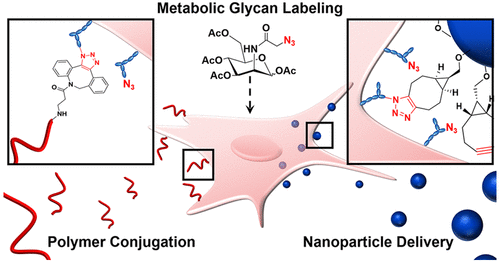当前位置:
X-MOL 学术
›
ACS Macro Lett.
›
论文详情
Our official English website, www.x-mol.net, welcomes your feedback! (Note: you will need to create a separate account there.)
100th Anniversary of Macromolecular Science Viewpoint: Re-Engineering Cellular Interfaces with Synthetic Macromolecules Using Metabolic Glycan Labeling.
ACS Macro Letters ( IF 5.8 ) Pub Date : 2020-06-25 , DOI: 10.1021/acsmacrolett.0c00317 Ruben M F Tomás 1 , Matthew I Gibson 1
ACS Macro Letters ( IF 5.8 ) Pub Date : 2020-06-25 , DOI: 10.1021/acsmacrolett.0c00317 Ruben M F Tomás 1 , Matthew I Gibson 1
Affiliation

|
Cell-surface functionality is largely programmed by genetically encoded information through modulation of protein expression levels, including glycosylation enzymes. Genetic tools enable control over protein-based functionality, but are not easily adapted to recruit non-native functionality such as synthetic polymers and nanomaterials to tune biological responses and attach therapeutic or imaging payloads. Similar to how polymer–protein conjugation evolved from nonspecific PEGylation to site-selective bioconjugates, the same evolution is now occurring for polymer–cell conjugation. This Viewpoint discusses the potential of using metabolic glycan labeling to install bio-orthogonal reactive cell-surface anchors for the recruitment of synthetic polymers and nanomaterials to cell surfaces, exploring the expanding therapeutic and diagnostic potential. Comparisons to conventional approaches that target endogenous membrane components, such as hydrophobic, protein coupling and electrostatic conjugation, as well as enzymatic and genetic tools, have been made to highlight the huge potential of this approach in the emerging cellular engineering field.
中文翻译:

高分子科学观点诞辰100周年:使用代谢性糖蛋白标记重新设计具有合成大分子的细胞界面。
细胞表面功能很大程度上是由遗传编码的信息通过调节蛋白质表达水平(包括糖基化酶)来编程的。遗传工具能够控制基于蛋白质的功能,但不容易适应于招募非天然功能,例如合成聚合物和纳米材料,以调节生物反应并附着治疗或成像有效载荷。类似于聚合物-蛋白质结合从非特异性PEG化演变为位点选择性生物结合物的过程,现在聚合物-细胞结合也发生了同样的变化。该观点讨论了使用代谢聚糖标记安装生物正交反应性细胞表面锚定物以将合成聚合物和纳米材料募集到细胞表面的潜力,探索了不断扩大的治疗和诊断潜力。
更新日期:2020-07-21
中文翻译:

高分子科学观点诞辰100周年:使用代谢性糖蛋白标记重新设计具有合成大分子的细胞界面。
细胞表面功能很大程度上是由遗传编码的信息通过调节蛋白质表达水平(包括糖基化酶)来编程的。遗传工具能够控制基于蛋白质的功能,但不容易适应于招募非天然功能,例如合成聚合物和纳米材料,以调节生物反应并附着治疗或成像有效载荷。类似于聚合物-蛋白质结合从非特异性PEG化演变为位点选择性生物结合物的过程,现在聚合物-细胞结合也发生了同样的变化。该观点讨论了使用代谢聚糖标记安装生物正交反应性细胞表面锚定物以将合成聚合物和纳米材料募集到细胞表面的潜力,探索了不断扩大的治疗和诊断潜力。


























 京公网安备 11010802027423号
京公网安备 11010802027423号